How to measure the total power in a 3 phase electrical system with one current transformer?
-
IF current in all phases is equal then Power = Vphase x Iphase-phase x sqrt(3) x power factor. | The motor is presumably star connected. – Russell McMahon Aug 29 '20 at 03:50
-
1hat can't be done. there is no formaula to turn AC amps into watts. you're going to need to know the power factor of the load, and you're also going to need to guess the supply voltage, At-least the supply voltage is somewhat predictable, and can be guessed with moderate accuracy. – Jasen Слава Україні Aug 29 '20 at 04:09
-
There is no formula without compromising what you mean by power. – Andy aka Aug 29 '20 at 07:28
-
@Jasen You can probably get a reasonable estimate of the kVA from Vnominal x Iphase x sqrt(3). And power from that IF power factor is known. – Russell McMahon Aug 29 '20 at 11:03
-
1Why do you have time to massively edit your question but not upvote my answer, which is technically correct? The "rep" is irrelevant - the fact that you seem to be ignoring the answer is puzzling. – Russell McMahon Aug 30 '20 at 09:10
2 Answers
Calculating the power (assuming a balanced load), using voltage and current readings alone, would be a problem in a single phase AC system itself, since the power factor would not be known.
AC Power = V * I * Cos φ
Hence an AC Wattmeter is a must.
With a star-connected load, the power in one phase could be measured with line current being fed to the current coil of the wattmeter and the phase voltage (line-to-neutral voltage) to the potential coil. The total power would be 3 * wattmeter reading.
In the case of a delta-connected load, the measurement would require the phase current to be fed to the current coil of the wattmeter and the line voltage to the potential coil. However, access to measure the phase current would be the main problem. The solution would be to use two wattmeters, with line currents and line voltages being fed to the current and potential coils. The total power would be the sum of the wattmeter readings.
This method would be applicable to a star-connected load also.
- 15,929
- 1
- 14
- 42
-
A single wattmeter can be used in the star connected case with V measure phase to phase and the reading multiplie by sqrt(3) (as per my answer). – Russell McMahon Aug 30 '20 at 09:11
-
11. Yes 2. No :-). | 3 x phase to neutral voltage reading, yes. BUT (see my answer) Vphase = Vline / sqrt(3) eg 400V / 1.732 = 230 V. | So Iphase x Vline / sqrt(3) * 3 = iIphase x Vline x sqrt(3) – Russell McMahon Aug 30 '20 at 13:04
-
Hi Russel McMahon, I am sorry I deleted my earlier comment by mistake. You are correct about my second statement being wrong. Your formula P = √3 * Vline * Iphase * Cos φ is also absolutely correct. But that would not be the reading in either of the wattmeters. One of them would read P1 = Vline * Iphase Cos (30 - φ) and the other P2 = Vline * Iphase * Cos (30+ φ). A study of the vector diagram makes it apparent. The sum of the two readings would be the 3 phase power. Hence the 2 wattmeters are a must for both star and delta loads. – vu2nan Aug 30 '20 at 19:57
-
Noted. Intuitively it seems that in star connection a wattmeter across the load should give 1/3 the total power fir a balanced load. Or 3 independent wattmeters give total power for unbalanced loads. That's effectively what you get in eg a residential 3 phase distribution where each residence 'sees' only the local phase to neutral conditions. If you cannot get true power in one load without access to 2 phases then all home 1 phase meters must be in error. Yes? – Russell McMahon Aug 31 '20 at 01:24
-
Hi Russell, The readings of domestic single phase meters, working only with phase voltages and currents, would all be correct and their sum total would also be correct. The Cos φ difference crops up only when the meter has to deal with phase current and line voltage. – vu2nan Aug 31 '20 at 04:23
Modern power meters that take account of power factor are now very low cost. Power in one phase x 3 is liable to be a reasonable estimate of total power.
However, if a power meter is not available, then IF current in all phases is equal then
Power = Vphase-to-phase x Iphase x sqrt(3) x power factor.
This is because Vphase = Vphase-to-phase / sqrt(3)
And you have 3 phases with equal power so
Total power = Vphase-to-phase / sqrt(3) x Iphase x 3
= Vphase-phase x sqrt(3) x Iphase
Power factor can be measured or inferred from AC motor theory (much on web)
- 147,325
- 18
- 210
- 386


